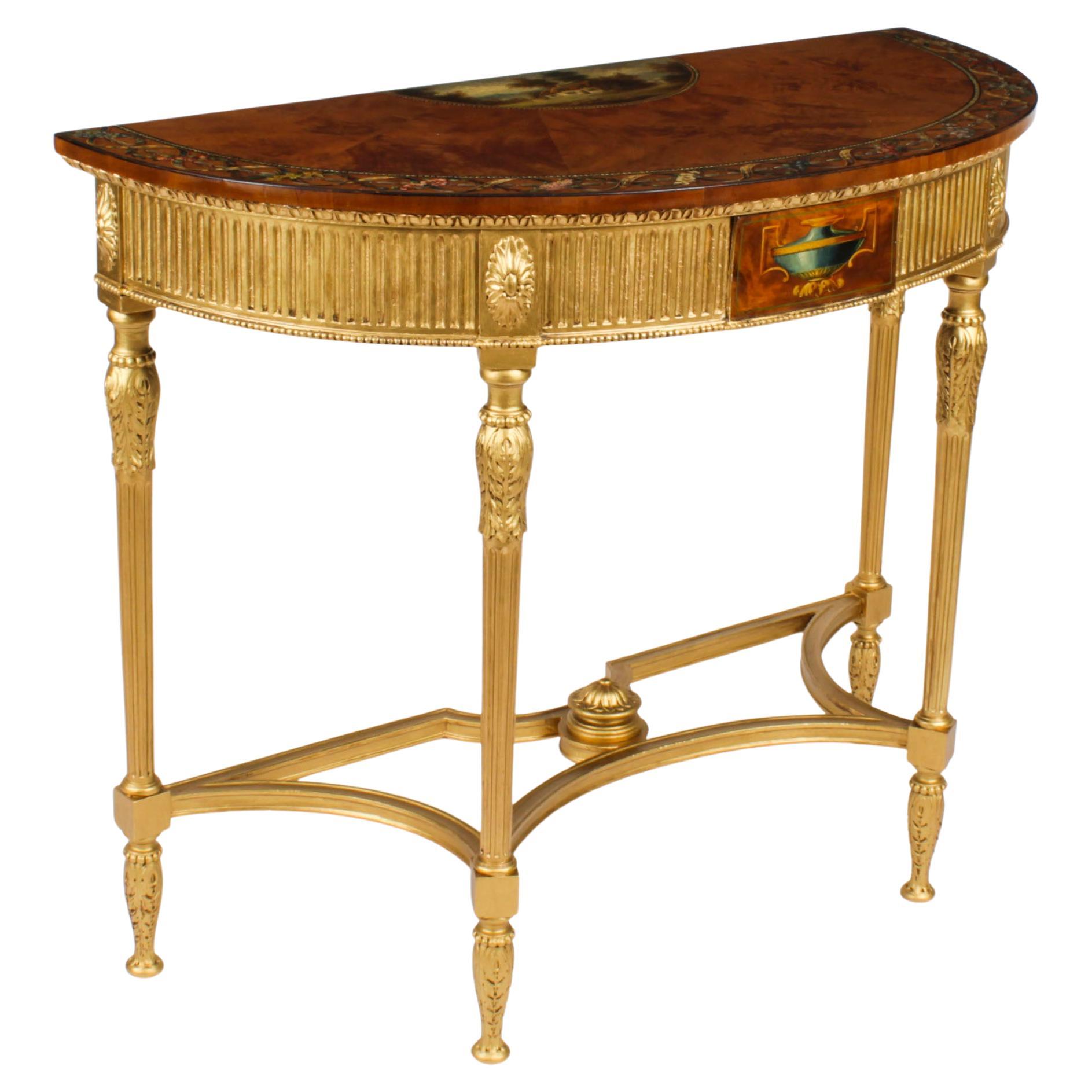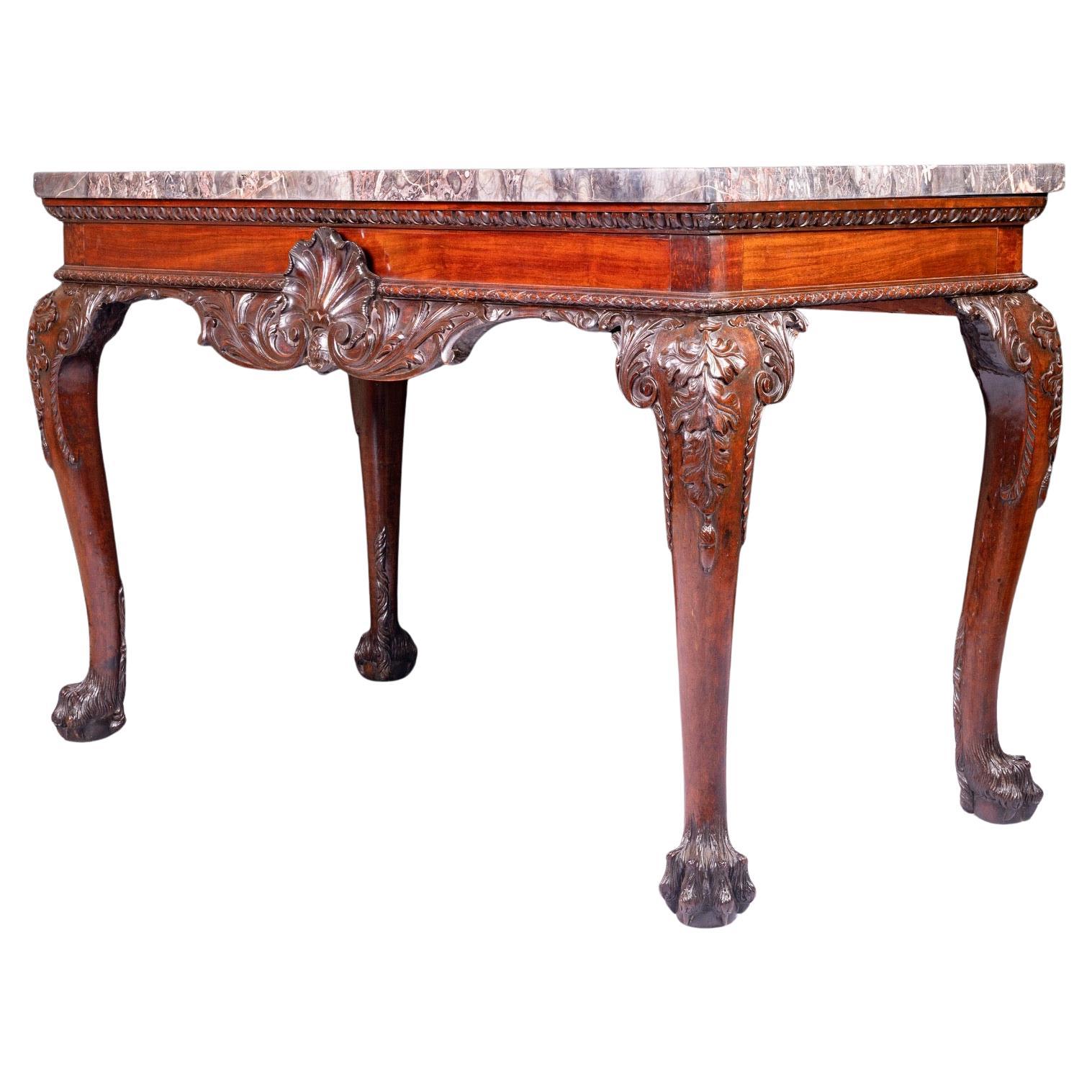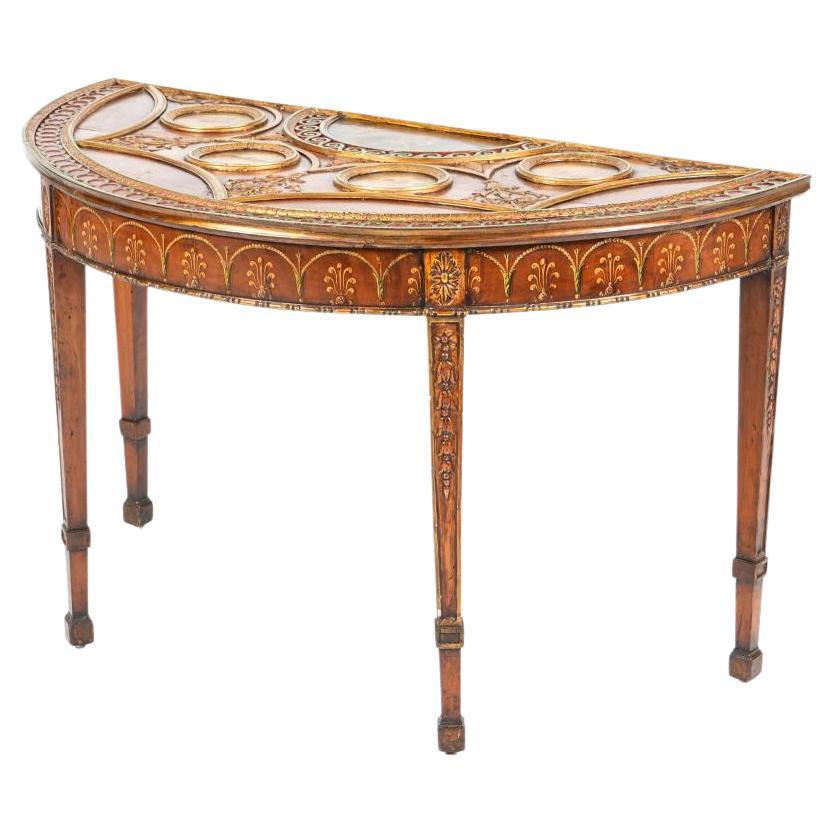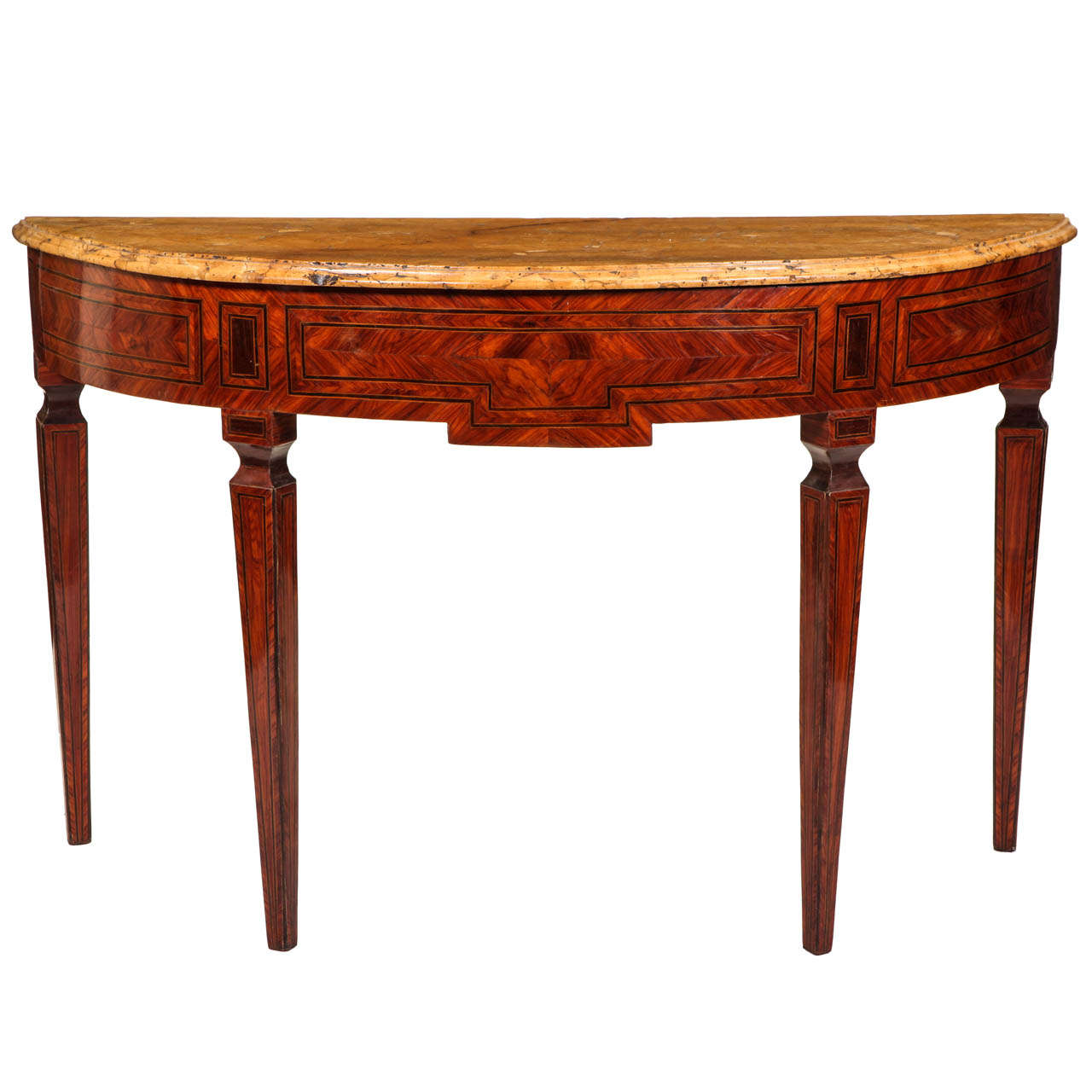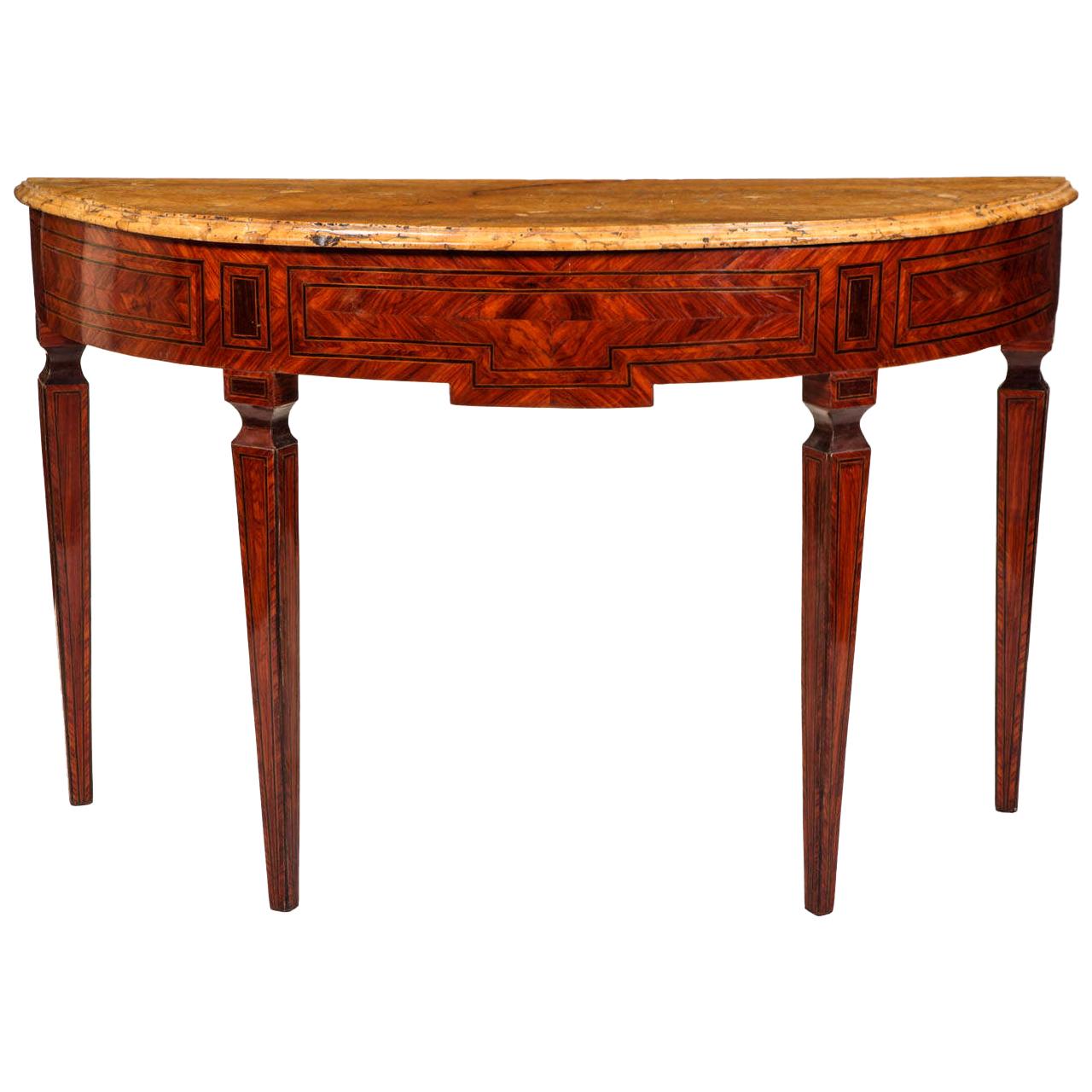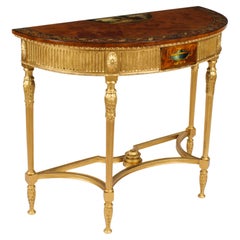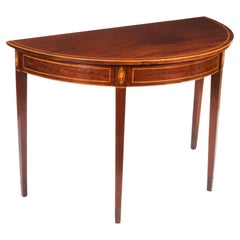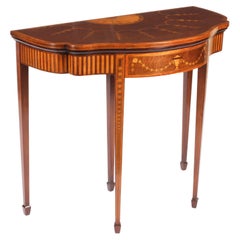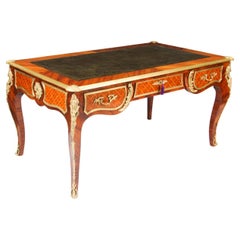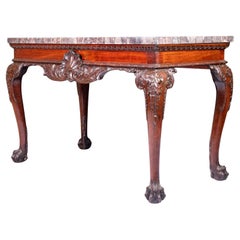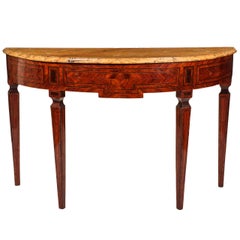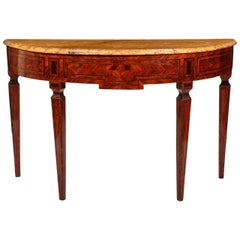Items Similar to Antique George III Satin Wood Painted Demi-Lune Console Table 18th Century
Video Loading
Want more images or videos?
Request additional images or videos from the seller
1 of 21
Antique George III Satin Wood Painted Demi-Lune Console Table 18th Century
$6,686.26
£4,850
€5,663.57
CA$9,244.95
A$10,149.80
CHF 5,295.17
MX$122,826.75
NOK 66,366.79
SEK 62,534.96
DKK 42,277.02
About the Item
This is a beautiful antique George III satin wood hand-painted and parcel gilt wood breakfront console table, circa 1780 in date.
The console is of Sheraton design, the crossbanded top features a border of trailing foliage and flowers and it has a charming central oval painted vignette of figures making music, painted in the manner of Angelica Kauffman.
The console has a decorative carved floral lunette frieze and is raised on four legs with stunning wreath and acanthus carved decoration. The legs are united by an under tier centred with a painted musical and floral trophy. The legs terminate in toupee feet.
The quality and attention to detail throughout is second to none.
Provenance:
A Private Collection, Staffordshire
Condition:
In excellent condition having only been beautifully cleaned and waxed in our workshops, please see photos for confirmation.
Dimensions in cm:
Height 81 cm x Width 104 cm x Depth 43 cm
Dimensions in inches:
Height 2 foot, 8 inches x Width 3 foot, 5 inches x Depth 1 foot, 5 inches
Satin wood
is a hard and durable wood with a satinlike sheen, much used in cabinetmaking, especially in marquetry. It comes from two tropical trees of the family Rutaceae (rue family). East Indian or Ceylon satin wood is the yellowish or dark-brown heartwood of Chloroxylon swietenia.
The lustrous, fine-grained, usually figured wood is used for furniture, cabinetwork, veneers, and backs of brushes. West Indian satin wood, sometimes called yellow wood, is considered superior. It is the golden yellow, lustrous, even-grained wood found in the Florida Keys and the West Indies.
It has long been valued for furniture. It is also used for musical instruments, veneers, and other purposes. Satin wood is classified in the division Magnoliophyta, class Magnoliopsida, order Sapindales, family Rutaceae.
Angelica Kauffman, RA (1741 - 1807)
was a Swiss-born Austrian Neoclassical painter who had a successful career in London and Rome. Though born as "Kauffmann", Kauffman is the preferred spelling of her name in English; it is the form she herself used most in signing her correspondence, documents and paintings.
While Kauffman produced many types of art, she identified herself primarily as a history painter, an unusual designation for a woman artist in the 18th century. History painting, was considered the most elite and lucrative category in academic painting during this time period. Under the direction of Sir Joshua Reynolds, the Royal Academy made a strong effort to promote history painting to a native audience who were more interested in commissioning and buying portraits and landscapes.
Despite the popularity that Kauffman enjoyed in British society and her success as an artist, she was disappointed by the relative apathy that the British had towards history painting. Ultimately she left Britain for the continent, where history painting was better established, held in higher esteem and patronized.
The works of Angelica Kauffman have retained their reputation. By 1911, rooms decorated with her work were still to be seen in various quarters. At Hampton Court was a portrait of the duchess of Brunswick; in the National Portrait Gallery, a self-portrait. There were other pictures by her at Paris, at Dresden, in the Hermitage at St Petersburg, in the Alte Pinakothek atMunich, in Kadriorg Palace, Tallinn (Estonia).
Thomas Sheraton
(1751 - 1806) was an English cabinetmaker and one of the leading exponents of Neoclassicism. Sheraton gave his name to a style of furniture characterised by a feminine refinement of late Georgian styles and became the most powerful source of inspiration behind the furniture of the late 18th century. His four-part Cabinet-Maker and Upholsterers’ Drawing Book greatly influenced English and American design.
Sheraton was apprenticed to a cabinetmaker, but he became better known as an inventor, artist, mystic, and religious controversialist. Initially he wrote on theological subjects, describing himself as a “mechanic, one who never had the advantage of collegiate or academical education.” He settled in London c. 1790, and his trade card gave his address as Wardour Street, Soho.
Supporting himself mainly as an author, Sheraton wrote Drawing Book (1791), the first part of which is devoted to somewhat naive, verbose dissertations on perspective, architecture, and geometry and the second part, on which his reputation is certainly based, is filled with plates that are admirable in draftsmanship, form, and proportion.
In 1803 Sheraton, who had been ordained a Baptist minister in 1800, published his Cabinet Dictionary (with plates), containing An Explanation of All Terms Used in the Cabinet, Chair and Upholstery Branches with Dictionary for Varnishing, Polishing and Gilding.
Some of the designs in this work, venturing well into the Regency style, are markedly unconventional. That he was a fashionable cabinetmaker is remarkable, for he was poor, his home of necessity half shop. It cannot be presumed that he was the maker of those examples even closely resembling his plates.
Although Sheraton undoubtedly borrowed from other cabinetmakers, most of the plates in his early publications are supposedly his own designs. The term Sheraton has been recklessly bestowed upon vast quantities of late 18th-century painted and inlaid satin wood furniture, but, properly understood and used in a generic sense, Sheraton is an appropriate label recognizing a mastermind behind the period. The opinion that his lack of success was caused by his assertive character is hypothetical.
Our reference: A4612
- Dimensions:Height: 31.89 in (81 cm)Width: 40.95 in (104 cm)Depth: 16.93 in (43 cm)
- Style:George III (Of the Period)
- Materials and Techniques:
- Place of Origin:
- Period:1780-1789
- Date of Manufacture:circa 1780
- Condition:
- Seller Location:London, GB
- Reference Number:Seller: A46121stDibs: LU950646174652
About the Seller
5.0
Platinum Seller
Premium sellers with a 4.7+ rating and 24-hour response times
Established in 1983
1stDibs seller since 2012
1,398 sales on 1stDibs
Typical response time: <1 hour
Associations
LAPADA - The Association of Arts & Antiques Dealers
- ShippingRetrieving quote...Shipping from: London, United Kingdom
- Return Policy
Authenticity Guarantee
In the unlikely event there’s an issue with an item’s authenticity, contact us within 1 year for a full refund. DetailsMoney-Back Guarantee
If your item is not as described, is damaged in transit, or does not arrive, contact us within 7 days for a full refund. Details24-Hour Cancellation
You have a 24-hour grace period in which to reconsider your purchase, with no questions asked.Vetted Professional Sellers
Our world-class sellers must adhere to strict standards for service and quality, maintaining the integrity of our listings.Price-Match Guarantee
If you find that a seller listed the same item for a lower price elsewhere, we’ll match it.Trusted Global Delivery
Our best-in-class carrier network provides specialized shipping options worldwide, including custom delivery.More From This Seller
View AllAntique Satinwood Hand Painted Demi-Lune Console Table 19th Century
Located in London, GB
This is a elegant antique satinwood hand painted giltwood demi-lune console table , Circa 1880 in date.
The demi lune top beautifully painted in the manner of Angelica Kauffman and features a landscape scene with a picturesque cottage and a painted border of ribbons, floral and foliate decoration.
The giltwood frieze has a painted classical urn crest and carved fluting with anthemion mounts. The four tapering legs are decorated with acanthus and further fluting and united with a decorative shaped undertier.
This piece is truly unique and is guaranteed to bring beauty and charm to your home for many years to come.
Condition:
In excellent condition, please see photos for confirmation.
Dimensions in cm:
Height 86.5 x Width 107 x Depth 48
Dimensions in inches:
Height 2 foot, 10 inches x Width 3 foot, 6 inches x Depth 1 foot, 7 inches
Angelica Kauffman, RA (1741 - 1807)
was a Swiss-born Austrian Neoclassical painter who had a successful career in London and Rome. Though born as "Kauffmann", Kauffman is the preferred spelling of her name in English...
Category
Antique 1880s Console Tables
Materials
Satinwood, Giltwood
Antique George III Demi Lune Console Side Hall Table 18th C
Located in London, GB
This is a superb antique flame mahogany and chequer strung demi-lune console table, Circa 1780 in date.
This splendid console table is made of the finest quality flame mahogany a...
Category
Antique 1780s English George III Console Tables
Materials
Mahogany
Antique Mahogany and Satinwood Inlaid Serpentine Card Console Table 19th Century
Located in London, GB
This is a superb antique mahogany serpentine fold-over card table, circa 1880 in date.
This splendid card table is made of the finest quality mahogany and features a hinged foldover shaped top with a demi-lune motif of fanned satinwood & green stained hare-wood surrounded by radial spurs of bell-flowers between swagged bands, bordered with satinwood cross-banding outlined with stringing.
The frieze inlaid with fluting and having a bow front drawer to the centre adorned with swagged bell-flower chains, with further pendant garlands leading down the square tapering legs on spade feet.
The quality and attention to detail throughout are second to none.
THE BOTANICAL NAME FOR THE MAHOGANY THAT THIS CARD TABLE IS MADE OF IS SWIETENIA MACROPHYLLA AND THIS TYPE OF MAHOGANY IS NOT SUBJECT TO CITES REGULATION.
Condition:
In excellent condition having been beautifully cleaned, polished and waxed in our workshops and the baize relined, please see photos for confirmation.
Dimensions in cm:
Height 78 x Width 92 x Depth 47
Dimensions in inches:
Height 2 foot, 7 inches x Width 3 foot x Depth 1 foot, 6 inches
Satinwood
is a hard and durable wood with a satinlike sheen, much used in cabinetmaking, especially in marquetry. It comes from two tropical trees of the family Rutaceae (rue family). East Indian or Ceylon satinwood is the yellowish or dark-brown heartwood of Chloroxylon swietenia.
The lustrous, fine-grained, usually figured wood is used for furniture, cabinetwork, veneers, and backs of brushes. West Indian satinwood, sometimes called yellow wood, is considered superior. It is the golden yellow, lustrous, even-grained wood found in the Florida Keys...
Category
Antique 1880s Card Tables and Tea Tables
Materials
Mahogany, Satinwood
Antique Louis Revival Ormolu Mounted Bureau Plat Desk 19th Century
Located in London, GB
This is a gorgeous antique French Louis Revival gilt bronze mounted amaranth bureau plat, Circa 1860 in date.
The shaped top has a decorative gilt ...
Category
Antique 1860s French Desks and Writing Tables
Materials
Ormolu
Antique French Neo-Classical Gilded & Marble Top Console Table 1820s
Located in London, GB
This is a beautiful antique French Neo-Classical giltwood marble topped console table, Circa 1820 in date.
The table has a wonderful shaped variegated grey and white grain marble t...
Category
Antique 1820s Console Tables
Materials
Marble
Antique George III Inlaid Flame Mahogany Sideboard, 18th Century
Located in London, GB
This is a superb antique George III inlaid flame mahogany bowfront sideboard, circa 1780 in date.
The top is banded in satinwood and...
Category
Antique 1780s English George III Sideboards
Materials
Mahogany
You May Also Like
19th Century Irish George III Style Console Table
Located in Dublin, IE
A superb 19th century George III style console / side table. The rectangular marble top above a shaped punched apron centered by a Scallop and flanking foliate scroll work and simila...
Category
Antique 19th Century Irish George III Console Tables
Materials
Marble
Late 18th Century Adam Painted and Gilt Satinwood Demilune Console Table
Located in Essex, MA
Rare and Fine Late 18th Century George III Adam Satinwood Demi-lune Console Table. Inset Neoclassical Top with Roundels of Putti and Venus. Glass covering the top. Frieze with Pal...
Category
Antique Late 18th Century English Adam Style Demi-lune Tables
Materials
Satinwood
Fine Italian 18th Century Marquetry Console Table
Located in Rome, IT
A Fine Italian 18'century marquetry Demi-lune Console Table with Siena Marble Top .
Sicily, second half of the 18'century.
Category
Antique 18th Century Italian Louis XVI Console Tables
Materials
Wood
Elegant Italian 18th Century Marquetry Console Table
Located in Rome, IT
Amazing Italian 18th century marquetry demilune console table with Siena marble top.
Sicily, second half of the 18th century.
Category
Antique 18th Century Italian Louis XVI Console Tables
Materials
Wood
$17,340 Sale Price
20% Off
18th Century Adams Painted Decorated Demilune Two Tier Console Table
Located in Swedesboro, NJ
This 18th century Adams style painted decorated demilune two-tier console table is a superb example of neoclassical English furniture, inspired by the celebrated designs of Robert Ad...
Category
Antique 1790s English Adam Style Commodes and Chests of Drawers
Materials
Walnut
$2,396 Sale Price
44% Off
Edwardian Satinwood, Gilded and Painted Console Table
Located in Essex, MA
In the style of Robert Adam. Very fine quality with demilune top painted with classical scenes and floral garlands over a frieze with central painted panel and flanked by gilt wood l...
Category
Antique Late 19th Century English Edwardian Console Tables
Materials
Satinwood
More Ways To Browse
Antique Drawing Book
Hampton Court
18th Century George Iii Painting
Antique Dining Room Table With 8 Chairs
Dining Table And 8 Chairs Antique
8 Foot Antique Dining Table
Marquetry Dining Table And Chairs
Half Wood 3 Leg Table
Swiss Hand Carved Wood Chairs
Names Of Antique Furniture
Oval Dining Table And 8 Chairs
Antique Oval Table And Chairs
18th Century American Portrait Painting
Regency Style 2 Tier Table
Burl Console With Drawer
Calligraphic Sculpted Brass Console By Misaya
Chinese Jichimu
Colosseum Console Table
